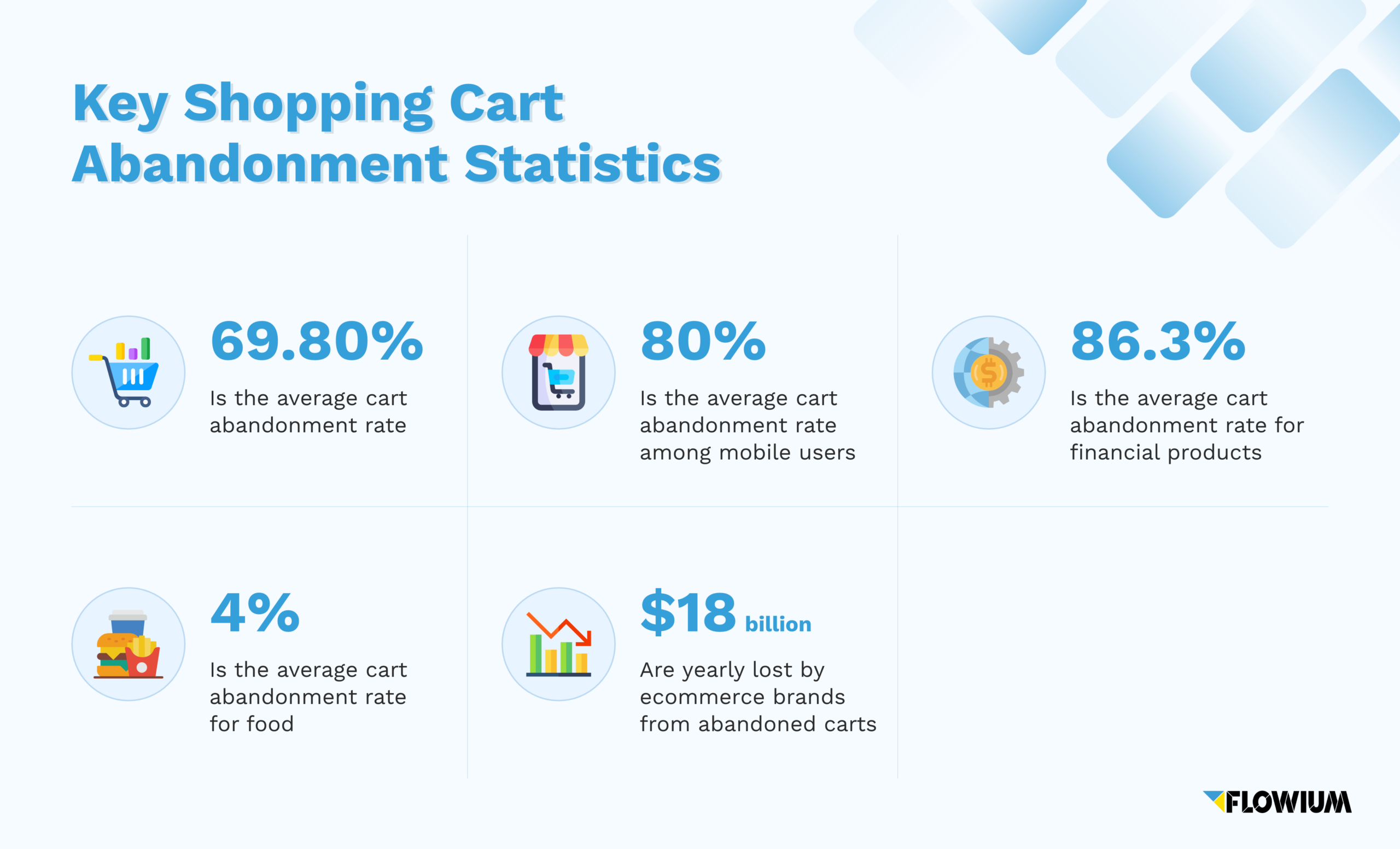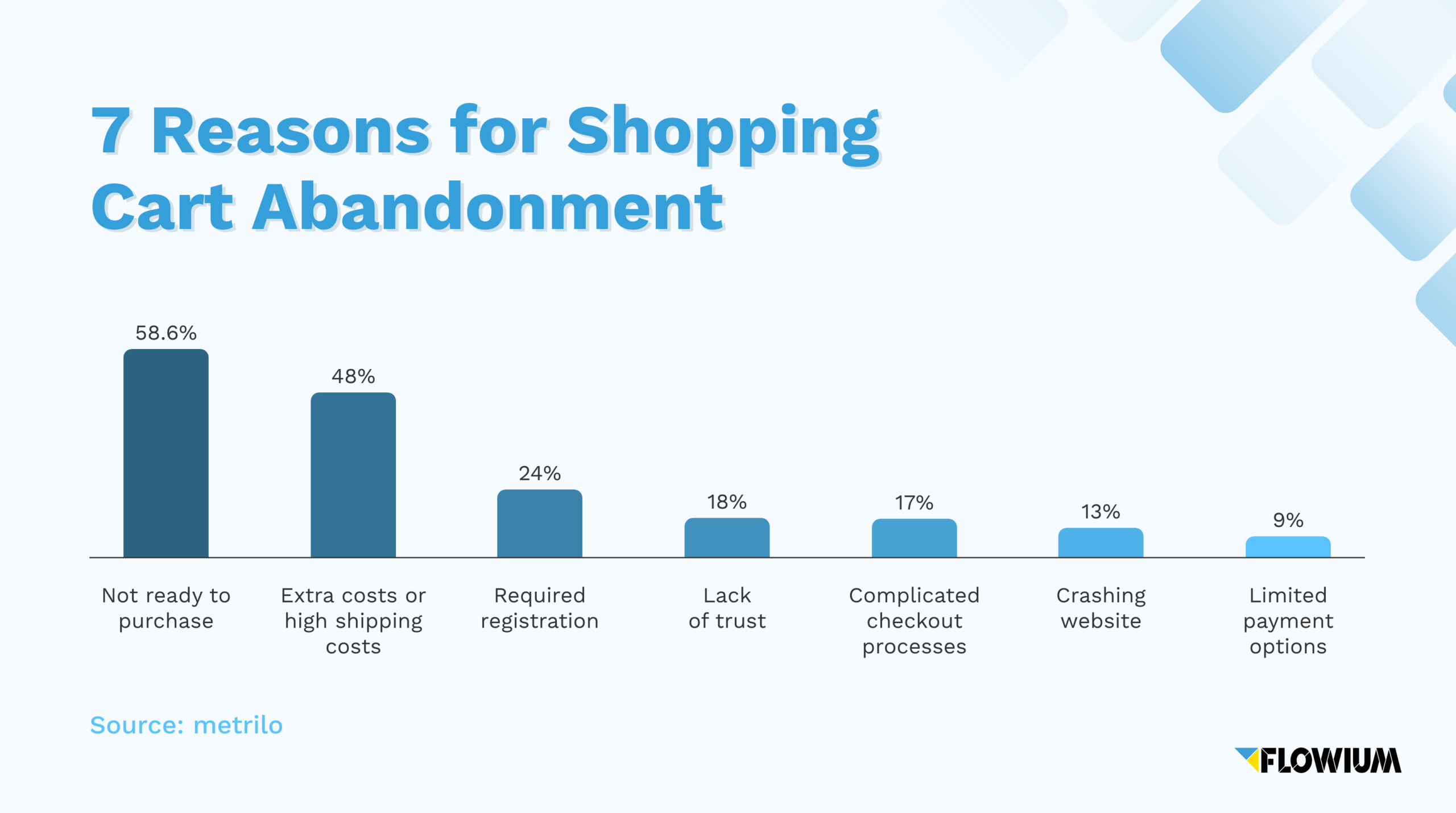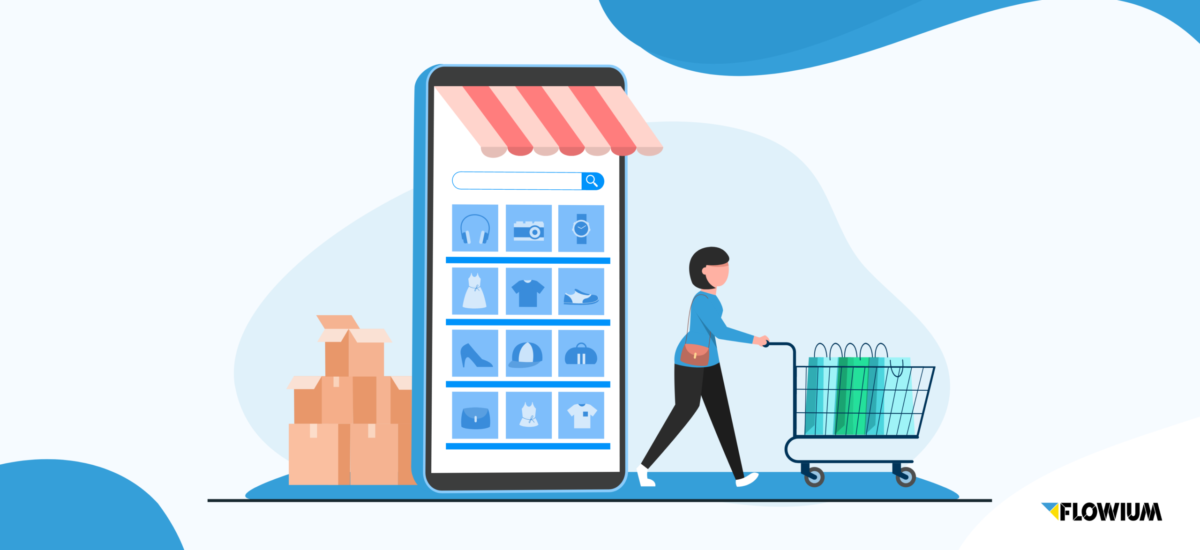No matter how long you have been dabbling in eCommerce, you must have encountered abandoned carts.
These are situations where a customer adds one or more items to their cart but doesn’t complete the purchase. Simply put, he or she simply gives up on the purchase and moves on.
And while it is expected that some customers are simply window shoppers, when the abandonment rate keeps increasing, it is a clear indication of a greater problem.
So to avoid escalation, it is best to keep up with shopping cart abandonment statistics, calculate your abandonment rate, and monitor it over time.
What is the Average Cart Abandonment Rate and How to Calculate It?
Cart abandonment rate is the “percentage of shopping carts that were abandoned”. It is the rate of potential customers who are interested in buying a product online but leave without buying anything, compared to the number of shopping carts created.
How to calculate the cart abandonment rate?
Cart abandonment rate is calculated by dividing the number of completed purchases by the number of shopping carts created.
This result is subtracted from 1 and then multiplied by 100 to obtain the abandonment rate.
Mathematically, this is expressed as:

So if you get 300 completed transactions from 1500 initiated shopping carts, your cart abandonment rate will be 80% as calculated below:
[1 – (300/1500)] * 100
= [1 – 0.2] * 100
= 0.8*100
= 80%
This formula can be easily used for quick results on guard abandonment rate on your e-commerce site. You can use this formula to calculate cart abandonment rate for your entire store, a device type, or a specific region.
💡 Once you have found out your average cart abandonment rate, you need to take measures to reduce the percentage by maximizing sales.
Why is it important to know your cart abandonment rate?
Cart abandonment is one of the most important metrics for e-commerce sites, as it indicates that customers aren’t going through with their purchases – so there must be something during the checkout process that stops them from buying.
A high cart abandonment rate usually means one of two things: your sales funnel isn’t working as expected, or your store isn’t well-optimized for user experience.
Knowing your average cart abandonment rate will help you identify marketing tactics that are working and those that aren’t.
It will help you understand how your site visitors interact with the store and show you the areas that may be causing issues when converting visitors into customers.
A high cart abandonment rate means you’re losing potential customers on the checkout pages. It can show you how trustworthy your checkout process is and indicate whether your revenue will go up or down.
💡 By understanding why customers are abandoning their carts, you can start to make changes that will help reduce the cart abandonment rate.
Don’t limit yourself to the average cart abandonment rate
As important as it may be, the cart abandonment rate is just an initial flag that points out what may be wrong. Yet, it’s not something that you can rely on to solve the problem of abandoned carts.
To do that, you’ll need a deeper overview of different metrics that can help you identify where the problem lies.
For example, one area you should look at more closely is your sales funnel. Where are your visitors dropping off as they move through your funnel?
Once you find the answer to this question, you will be able to determine where you need to put more focus when trying to fix the issue of abandoned carts.
The Shopping Cart Abandonment Statistics You Need to Know
Knowing the average cart abandonment rate is important for your eCommerce store as it helps you understand how much of your revenue is lost due to customers not completing their purchases.
But cart abandonment rates vary widely between different industries and even within the same category of products. For example, a clothing store will likely have a higher cart abandonment rate than an electronics store.
So, before jumping to a conclusion, it’s best to do some research and get familiar with the cart abandonment statistics for your industry and beyond.
Let’s take a look at some of the most important ones.

1. The average abandoned cart percentage stands at 69.80%
Typically, the cart abandonment rate percentage falls between 60% and 80%.
A lot of research has been done to estimate the average cart abandonment rate over the years. This has produced figures as low as 55% and as high as 84%.
So to come up with a clear picture, the Baymard Institute calculated the average of the results of 44 recent studies, coming up with a whopping 69.80%.
Even if we assume that half of this percentage can be attributed to people who were window shopping, this value is still really high.
💡 Although you can never get your abandoned cart percentage to zero, the lower you get, the better – some people even claim it’s possible to get down to 20%.
2. The average abandoned cart percentage rises to over 80% among mobile users
Interestingly, the smaller the screen the customer used to shop, the higher the chances that they won’t complete their purchase.
Research shows that mobile phones have higher cart abandonment rates. In fact, it is the worst out of all devices, with an abandoned cart rate as high as 85.65% on average.
And since more people use their phones to shop rather than computers, this poses a serious threat to online sellers everywhere.
But there is a silver lining – you can easily optimize your eCommerce site for mobile users:
- You can increase your mobile site speed so that buyers don’t have to sit around waiting for pages to load
- You can reduce your site copy and only leave the essentials.
3. The cart abandonment rate for financial products is 86.3%, while that of food is 4%
One thing you should understand about the cart abandonment rate is that it varies from one type of product to another.
The more essential a product is, the more likely customers are to complete their purchase. That’s why food has an abandonment rate of only 4% while that of clothes is 40%.
On the other hand, the more complex the product or the checkout page, the less likely customer are to finish their purchase. That’s why the finance and travel industries, for example, have an average cart abandonment rate of over 80%.
Similarly, industries that heavily rely on reviews and advertising – such as the gaming industry – have a lower shopping cart abandonment rate simply because the customer can preview and verify the product before buying it.
This makes the purchase more direct, since the customer that arrives at your checkout page has already decided to buy your product.
4. Brands lose billions in sales revenue due to cart abandonment
After customers abandon their carts, they rarely come back.
To give you some perspective, here are some Statista research insights into what UK shoppers do after cart abandonment:
- 31% come back later to complete their purchase
- 26% buy the same item from another online retailer
- 23% don’t buy the item at all
- 8% buy the item from a physical store.
💡 In fact, cart abandonment costs brands $18 billion in sales revenue yearly.
So if you have or are planning to start an online store, its cart abandonment rate is one metric you can’t afford to ignore.
7 Reasons for Shopping Cart Abandonment
There are many reasons why a buyer abandons their cart. Some of the reasons for cart abandonment rates are the following (based on Baymard Institute research).

1. People don’t like extra costs or high shipping costs
When it comes to buying things online, people value transparency.
They want to know exactly how much they will need to pay before they get to checkout. Otherwise, they feel blindsided.
It, therefore, shouldn’t be surprising that extra costs are the number one reason why people abandon their carts.
💡 Extra costs contribute to around 48% of abandoned carts. So be transparent and, when possible, offer free or discounted delivery.
One of the biggest reasons why customers abandon their shopping carts are shipping costs. If they are too high, they can be a major barrier for some customers because they simply didn’t expect to pay as much for shipping.
To avoid losing potential customers, you need to make sure that your shipping costs are clearly displayed on your site. And if you can, offer free shipping.
Unsatisfactory return policies can also be a big reason why people leave without completing their purchase.
Having a good return policy can help you convince customers that they will be able to return the product if it isn’t what they expected.
2. People don’t like creating accounts
The last thing you want to see when checking out your order is a prompt to create an account – 24% of cart abandonments actually occur at this point.
This is particularly a pain point for customers who are planning to make a one-time order.
So to lower the chances of cart abandonment, it is best to incorporate a way that customers can complete their orders without having to create an account.
💡 Shoppers want convenience above all else when making a purchase online, and will leave if they’re forced to jump through hoops just to make a purchase. The same goes for long delivery times – if they have to wait too long for their order to arrive, they’ll buy it elsewhere.
3. People like easy checkout processes
It’s no secret that the longer a checkout process is, the more likely a potential customer is to abandon their cart. In fact, around 17% of abandoned carts are due to long and complicated checkout processes.
A lengthy checkout process makes people lose interest in buying from you, especially if they have to fill out several forms before checking out.
Having a short and quick checkout process will prevent your customers from getting bored during the process. If they get bored, they’ll just leave without buying anything from you.
💡 To prevent your customers from bouncing, find ways to improve your site’s usability and use more effective checkout solutions.
4. People don’t buy from sites they don’t trust
In this age of cybercrime and identity theft, it’s only natural for people to be cautious about sharing their credit card information online.
In fact, 18% of abandoned carts are caused by people who don’t trust your site. They may like your product, but they are just not willing to take the risk.
So to gain their trust, here are some things you could do:
- Install an SSL certificate
- Showcase warranties
- Incorporate testimonials to your site
- Provide a variety of payment options.
5. People don’t like slow and complex websites
If your website is too complex and difficult to navigate, people will abandon their carts before completing the checkout process.
This is why it’s important to keep your site simple and easy to navigate so that customers don’t get frustrated while browsing or buying your products.
💡 If it takes too long for users to find what they want, they might abandon their carts and move on to another site.
One of the things you can do to prevent that is to provide a search feature on your website and an efficiently categorized product menu.
However, make sure not to overdo it! Having too many categories or products displayed on one page or category page can make your visitors feel overwhelmed. Break up your catalog into manageable sections, so users aren’t confused by too many choices and options.
Another thing that may cause your customer to abandon their purchase are technical problems with your site. These can be many things, such as slow-loading pages or broken links on your website.
A website that doesn’t run smoothly is a website that drives visitors away. Actually, 13% of abandoned shopping carts are due to websites that have errors or crash.
6. Limited payment options might make people abandon their cart
Offering only limited payment options can result in an abandonment cart.
Imagine that you want to order some clothes from an e-commerce store. You arrive at the checkout page with your American Express card in hand, and just when you’re ready to input your card details, it turns out that the store doesn’t accept American Express cards.
You’ll likely get frustrated and abandon your order rather than pay with a different card. At least, 9% of abandoned carts happen for that reason.
💡 Customers won’t hesitate to abandon their cart if their preferred payment option isn’t available on the checkout page.
7. People are sometimes not ready to buy
Sometimes, people just aren’t ready to buy. If your store visitor has a low intention of actually making a purchase, they’re more likely to abandon their cards.
People visit e-commerce stores for many reasons besides making a purchase.
It may be because they’re interested in learning about new products in your industry. Or because they’re bored at work and looking for something to do. Or because they’re looking for gift ideas for their nephew.
💡 In fact, the reason behind 58.6% of abandoned carts is this one: visitors are simply browsing without the intention to buy.
And, frankly, if your customer isn’t interested in buying anything, there’s not much you can do to make them change their mind.
When Should You Act to Decrease Your Cart Abandonment Rate?
Cart abandonment is a serious issue for e-commerce stores. A high cart abandonment rate means you’re losing money and potential customers. It also means that the customers that aren’t buying from you are likely buying from your competitor.
💡 Lowering your average cart abandonment rate is a very effective method to increase revenue immediately.
But the question is, when is the right time to act on reducing your cart abandonment rate?
Well, when you notice that your cart abandonment rate is higher than your industry’s average, you’ll know that something is wrong – and you’ll feel inclined to solve the problem immediately.
However, before you act, it’s important to understand what may be causing a higher cart abandonment rate. Sometimes, more abandoned carts may be a natural consequence of external factors, such as:
- The device your customer is using (for example, mobile phones cause a higher cart abandonment rate than desktops)
- Your buyer’s location (in some locations, people tend to shop more, so the number of abandoned carts is naturally higher)
- The type of item (for example, clothing and luxury items have naturally higher cart abandonment rates)
- Time of the year (more people are shopping during the holiday season and Black Friday Sale, which causes more abandoned carts)
In those cases, your cart abandonment rate may be temporarily higher, and you don’t need to take action.
However, if it’s consistently higher when it shouldn’t be, that’s when you have a problem that needs fixing.
10 Ways to Improve Your Abandoned Cart Rate
Discover below some of the best ways to reduce your average cart abandonment rate.

1. Check your website performance
We’re impatient creatures. In the age of 30-second Instagram Reels and 7-second TikToks, people’s attention span is now shorter than ever.
That’s why one of the most common reasons why people abandon their shopping carts is a slow-loading checkout page. If it doesn’t load fast, you’re going to lose visitors.
To prevent people from abandoning their carts, optimize your checkout page for faster loading. You can do this by checking your page loading time.
If it’s too high, review your checkout page and reduce the steps you require your customer to go through.
2. Create a return and refund policy
Another way to help reduce your shopping cart abandonment rates is to have a return and refund policy in place.
In fact, not having a strong return or refund policy is one of the main reasons shoppers abandon their carts, especially when it comes to items such as clothing.
When buyers know that they can return the product or get their money back if it doesn’t fulfill their expectations, they are more likely to complete their purchase.
💡 A clear return policy gives your customers confidence in the quality of your product and brand. This can help increase sales by eliminating the fear that they may lose money on a product they aren’t satisfied with.
Even if the return or refund policy may slightly reduce your profit margins, it can help you increase your sales significantly.
3. Be transparent about costs
No one likes to be surprised with unexpected fees right before they’re about to click on the “Buy” button.
According to a study by Baymard, 48% of shoppers abandon their carts due to extra costs being too high, and 16% do so because they can’t calculate the total costs of their orders up-front.
So, if you aim to reduce your cart abandonment rate, being transparent about your costs – such as shipping costs, taxes, and other extra fees – is extremely important. Transparency helps build customer trust and credibility and can prevent customer dissatisfaction and mistrust.
Similarly, showing the total savings – such as promo codes, special offers, and discounts – at checkout can encourage customers to make the purchase and, therefore, reduce the likelihood of them abandoning their shopping cart.
4. Offer free or discounted delivery
Around 48% of shoppers abandon their carts because of extra costs, including delivery costs. Consider offering free or discounted delivery to customers to boost sales.
Being transparent regarding delivery can also be a great way to reduce abandoned carts. Making it easy for your customers to trace shipping can increase trust and credibility and show them what to expect.
5. Make checking out easy
The success of your online store depends on how easily customers can check out. A lengthy and complex checkout process is one of the most common reasons for cart abandonment.
You can prevent this by making your checkout process seamless, quick, and easy. How?
Here are some ways to optimize your page for faster checkout:
- Create a one-click system allowing customers to purchase your product in a few clicks.
- Add a guest checkout option. This way, customers won’t have to create an account and enter many personal details to purchase the product.
- Place progress indicators at the bottom of the page to show customers how many steps are left.
- Include thumbnails of the products in the customer’s order through the checkout page to entice them to finish the checkout process.
6. Add extra payment methods
Adding extra payment methods on the checkout page is another great way to prevent shoppers from abandoning their carts.
If someone doesn’t have a credit card or Paypal account, they may feel like they can’t continue with their purchase. By offering various payment options, you make it more convenient for your customers to make purchases, which can increase conversions and customer loyalty.
Some alternative payment methods you can add on your checkout page besides credit and debit cards are:
- PayPal
- Apple Pay
- Google Pay
- Amazon Pay
- Cryptocurrency
- Gift cards and e-gift cards
- Installment payments
7. Include multiple calls to action
Adding several calls to action on your checkout page can be an effective way to reduce the cart abandonment rate.
💡 CTAs placed strategically around the page can reduce confusion and seamlessly guide the customer from one step to another, making it easy for them to go through the checkout process.
In addition, by providing multiple CTAs throughout the checkout process, you remind customers of what they’re about to purchase, which can help to keep them engaged and focused on completing the purchase.
To increase the customer’s confidence in their purchase even more, you can add phrases such as “secure checkout” or “money-back guarantee” next to your CTAs. This will provide customers with a sense of security and reassurance, making them more likely to complete the purchase.
8. Offer live chat support with experts
The ability to chat live with experts can help to reduce the cart abandonment rate because it allows customers to get personalized assistance with any questions or concerns they may have quickly and efficiently.
Sometimes, the reason why a customer doesn’t go through with their purchase is that they have doubts or objections that need clarifying.
Having a live chat can help to solve this problem, as it allows customers to voice their objections or concerns and have them addressed immediately. This can help to overcome any barriers to purchase and increase the likelihood that they will complete the purchase.
9. Highlight reviews from other customers
Another efficient way to reduce cart abandonment rates is to highlight product reviews from other customers through the checkout process.
💡 Online shoppers heavily rely on reviews from other customers to make their purchase decisions. If they can see that other people are satisfied with the product they’re about to buy, they will be more likely to complete their purchase.
By highlighting customer reviews in your product descriptions, you’re building trust and showing potential customers that other people were satisfied with what they bought from you in the past. This will help make sure they feel comfortable making purchases from your store.
10. Use abandoned cart emails
Abandoned cart emails in one of the most important methods to regain the trust of shoppers who abandoned their carts on your website.
Email marketing has a high success rate, and therefore sending abandoned cart emails to customers is a great way to get their attention back. There are many templates available for you to craft your emails.
Or better still, hire a professional to create the perfect emails for you and grab your customer’s attention.







